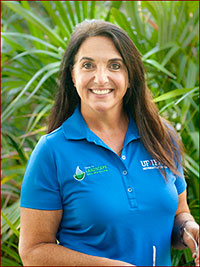Wendy's Wanderings
July 9, 2020
Plant and Insect ID
It seems this is no longer a drill. We are gardeners safe at home. The weeds are pulled, the hedges are trimmed, the beds are mulched, new plants are in, so now what? How about learning the names of all the plants and insects and that you see frequently in your landscape?
As Master Gardener Volunteers and gardening enthusiasts you probably know most of the common and scientific names of the plants and insects in your yard, but if there are unknowns or no-names out there, figure out what they are and learn more about them. Many gardeners are using plant ID apps like Plantsnap, Plantnet, and SEEK by iNaturalist. These apps are helpful, but your county Extension agent and IFAS Extension botanist can give you the final verdict. Likewise, insect identification is very important because you want to know the good bugs from the bad actors. You can find your county Extension agent with this map, and visit the UF/IFAS Diagnostics website for help with plant ID, insect identification, or other plant issues.
Knowing the names of the insect visitors to your yard is especially helpful in your Florida-Friendly Landscape™. When you know insect names and what their functions are in your landscape you can appreciate the role they play in your backyard ecosystem. It is important to be able to differentiate between the helpful and the harmful pests so you don't kill off an insect that was just there to help.
Insects like the leaffooted bug (Leptoglossus phyllopus) nymphs are often mistaken for the beneficial assassin bugs, and caterpillars that you purposely invited to you butterfly garden, might be confused with the larva of an unwanted guest. The poster child of beneficial insects, the lady beetle, is always welcome but the lady beetle larva is often confused for a leaf-munching grub or worse yet, as a mealybug, as in the case of the mealybug destroyer lady beetle, Cryptolaemus montrouzieri. This page on the UF/IFAS Extension Sarasota County website has a great listing of beneficial insects that you are likely to find in your Florida landscape.
Giving names to all the backyard residents can make you feel more connected to your yard and nature and help you see your landscape and natural areas with new eyes.
When you know their names and understand their origins and characteristics it is more like you are seeing old friends growing and buzzing around out there.
Consider this "stay at home" time an opportunity to get to know the plants and animals you share your space with. It will be like having a garden party where you know all the guests on a first-name basis.
-- Wendy Wilber

